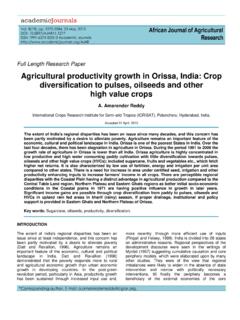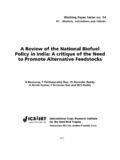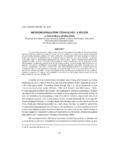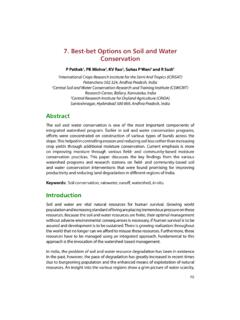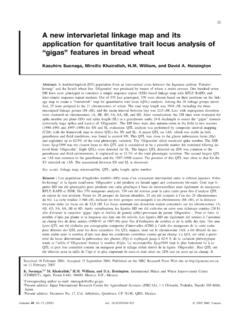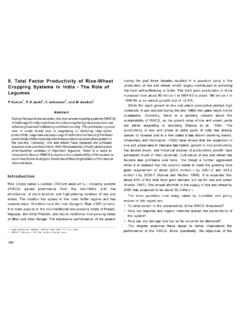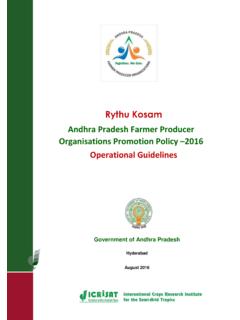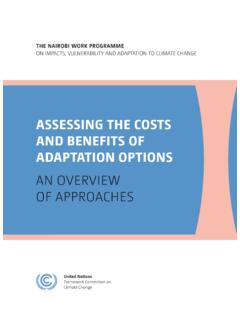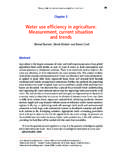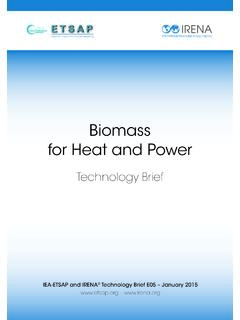Transcription of Climate change adaptation in agriculture: practices and ...
1 Climate change adaptation in agriculture: practices and technologies Messages to the SBSTA 44 agriculture workshops Dhanush Dinesh, Sonja Vermeulen FEBRUARY 2016 Key messages Many agricultural practices and technologies already provide proven benefits to farmers food security, resilience and productivity. Indigenous knowledge provides the backbone of successful Climate change adaptation in farming, livestock and fisheries. Agro-ecological zones and farming systems are extremely diverse. Thus interventions need to be targeted to specific contexts. Decision support to match practices and technologies with agro-ecological zones is a priority. Portfolios of practices and technologies are more likely to realize goals of food security, resilience and increased productivity. trade - offs and synergies among these goals may exist and the focus should be on maximizing synergies. Bringing practices and technologies to scale is possible and underway. Strong mechanisms for finance, capacity enhancement and technology transfer are prerequisites for success.
2 Engaging women in design and management of new technologies and practices will help close the gender gap in agriculture and deliver positive outcomes for the whole of society. Case studies demonstrate the potential for agricultural practices and technologies to achieve co-benefits for environmental health, and Climate change mitigation. In 2014 the United Nations Framework Convention on Climate change (UNFCCC) Subsidiary Body for Scientific and Technological Advice (SBSTA), as part of its mandate to consider issues related to agriculture, decided to invite submissions from parties and observers, covering four topics, in 2015 and 2016. Of the two topics for consideration in 2016, one relates to identification and assessment of agricultural practices and technologies to enhance productivity in a sustainable manner, food security and resilience, considering the differences in agro-ecological zones and farming systems, such as different grassland and cropland practices and systems.
3 In this info note we provide a brief overview of key practices and technologies. A twinned info note considers higher-level measures of adaptation in agriculture, such as policies and institutions. Both info notes are drawn from longer working papers, all freely available to download at Many agricultural interventions, such as integrated soil fertility management, can deliver Climate resilience and enhanced productivity. Photo: N. Palmer (CIAT). CCAFS INFO NOTE 2 Soil and land management Soil and land management interventions focus on enhancing soil health. Proven approaches build on existing indigenous practices and knowledge to maximize benefits to Climate change adaptation . In the West African Sahel, a range of indigenous practices contour stone bunds, half-moons, za address regional challenges of rainfall runoff and erosion, while increasing organic matter within the region s soils. Conservation agriculture covers nearly 157 million hectares 11% of the world s arable land area.
4 Highest adoption levels are in Latin America, particularly Brazil, Argentina and Paraguay. Conservation agriculture combines three practices : no-till, retention of crop residues in fields and regular fallow periods. It is particularly useful in regions where climates are projected to become drier, or extreme rainfall events more frequent. Integrated soil fertility management combines the use of appropriate amounts of organic and inorganic fertilizers together with well-adapted, disease- and pest-resistant germplasm, and good agronomic practices . ISFM is widely promoted across Africa. For example, in Malawi, about 30,000 farmers, as well as several hundred farmer associations and agricultural extension workers, have been trained in ISFM technologies. Site-specific nutrient management matches the supply of soil nutrients to context-specific needs of crops. For example, in India and Mexico, the Trimble GreenSeeker technology helps farmers calculate nutrient needs of crops.
5 Addressing site-specific nutrient needs has increased yields by 10% in India, while also reducing greenhouse gas emissions by 47%, by optimizing fertilizer use. Laser-assisted precision land levelling removes undulations in the soil surface using a tractor-towed laser-controlled device. The resulting flat and even surface, makes better use of water resources, increases cultivated area, reduces weeds and improves yields. It has been applied to over 500,000 hectares in India, saving 1 billion m3 of water. However, technical interventions need to be complemented with socio-ecological considerations. Tools like the Land Degradation Surveillance Framework, which has been applied in Uganda, Kenya, and Tanzania, can help to ensure that soil health and new farming practices contribute effectively to better livelihoods. Crop management Crop-specific innovations complement other practices that aim to improve crop production under Climate change , soil management, agroforestry, and water management.
6 Crop-specific innovations include breeding of more resilient crop varieties, diversification and intensification. In sub-Saharan Africa, the Drought Tolerant Maize for Africa initiative has released 160 drought-tolerant maize varieties between 2007 and 2013. These generate yields 25-30% superior to those of currently available commercial maize varieties under both stress and optimal growing conditions. In Andhra Pradesh, India, early maturing, disease- and heat-resistant chickpea varieties have more than doubled yields (from 583 to 1,407 kg per ha). Longer-term adaptation interventions include changes to crops cultivated. In the Peruvian Highlands, farmers who traditionally cultivate potato are expanding into organic quinoa, milk and cheese, trout, and vegetable production. This diversification is helping them improve farm incomes and reduce vulnerability to Climate change . In Burundi, Rwanda and Uganda, coffee-banana intercropping is proving to be effective in addressing increasing temperatures which affect coffee production.
7 Growing the two crops together can increase incomes by over 50% compared to mono-cropping either crop alone. In Viet Nam, over a million rice farmers have sustainably intensified rice production, by changing water and nutrient management. Inputs (fertilizers, seeds and water) have been reduced while yields have increased by 9-15% compared to conventional practices . Savings in input CCAFS INFO NOTE 3 costs improved farmer incomes by USD 95-260/ha, per crop and per season. Livestock management Improved or modified livestock management practices include improved grazing management, use of improved pasture and agroforestry species, better use of locally available feeds, the judicious use of highly nutritious diet supplements and concentrates, and breeding for heat-tolerance. Appropriate manure management can also increase soil organic matter and water-holding properties, leading to increased productivity of both food and fodder crops. Better animal health management, including surveillance and veterinary services, will improve animal performance and productivity.
8 Improving pasture and fodder offers a readily available way to increase livestock production. In parts of Latin America, Brachiaria grasses have been widely adopted with large economic benefits: animal productivity can be increased by 5-10 times compared with diets of native savanna vegetation. In Brazil, where about 99 Mha have been planted, annual benefits are about USD 4 billion. Similarly, growing tree fodder species, such as Leucaena leucocephala, on farms improves animals diets and productivity. Another important approach is cross-breeding. It is estimated that to meet projected milk and meat demand in 2030 using local breeds would need 363 and 173 million bovines, respectively; with 29% adoption of crossbreeds, this could be reduced to 308 and 145 million, respectively. An added benefit is the mitigation potential of about 6 Mt CO2 eq. In Nyando, Kenya, heat-, drought-, and disease- resistant crossbreeds of native sheep and goats are being introduced to increase resilience and productivity of farming households.
9 Forestry and agroforestry In smallholder farming systems, trees and forests are often key to livelihoods. Increasing forest cover and agroforestry can build resilience and environmental health, including mitigation benefits. In Niger, farmer-managed natural regeneration, which builds on indigenous knowledge, has expanded tree cover (from dormant rootstock) to 5 million hectares. In India, a first of its kind national agroforestry policy has been adopted, which aims to enhance the productivity, incomes and livelihoods of smallholder farmers. In Chile, La Corporaci n Nacional Forestal (CONAF) has designed a national certification system to measure adaptation performance of forest ecosystems. In West and Central Africa, farmers are expanding agroforestry intercropping, using cocoa alongside other trees, to deliver multiple benefits and more stable livelihoods. Fisheries and aquaculture Expansion and innovations in aquaculture offers cost-effective opportunities to provide sustainable sources of protein under Climate change .
10 For example, in Bangladesh, the use of field rings in rice fields for fish supplements household nutrition and provides an additional source of income. In China, multi-trophic fish farms combine complementary species to increase productivity through nutrient cycling. For capture fisheries, nearshore fish-aggregating devices have been deployed in the Solomon Islands, which improve household food security. Water management Agriculture is the largest user of the world's freshwater resources, using 70 % of the available supply. Improved water management can be achieved through capture and retention of rainfall, and improved irrigation practices . Soil fertility and crop management innovations also improve water use efficiency. In rice production, alternate wetting and drying can reduce water use by 30% and methane emissions by 48%. In Benin and Togo, low cost irrigation systems designed and developed by farmer groups involving bunds, drainage canals and irrigation infrastructure, have Agroforestry practices can help farmers diversify their crops and income, and enhance Climate resilience.
